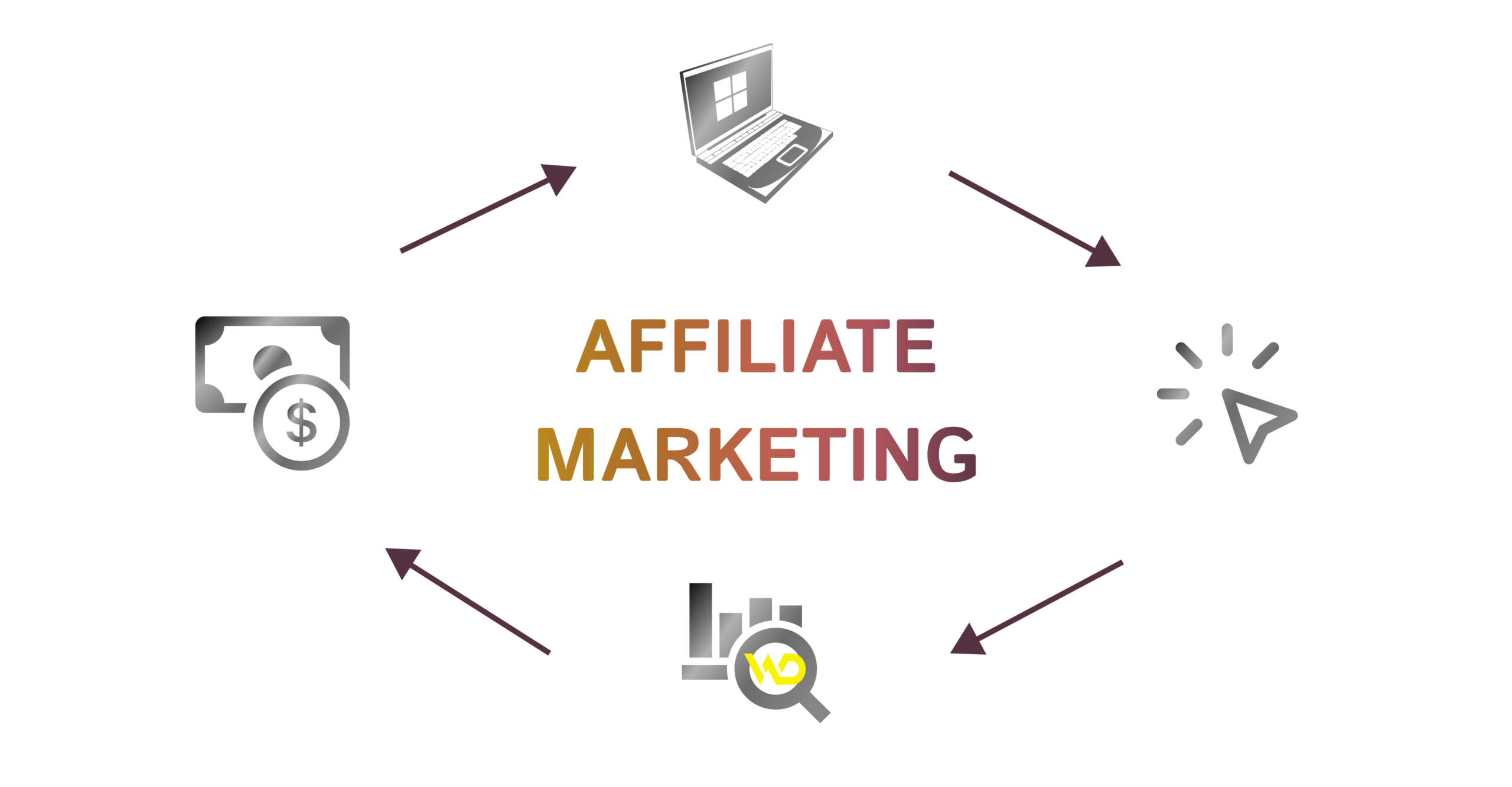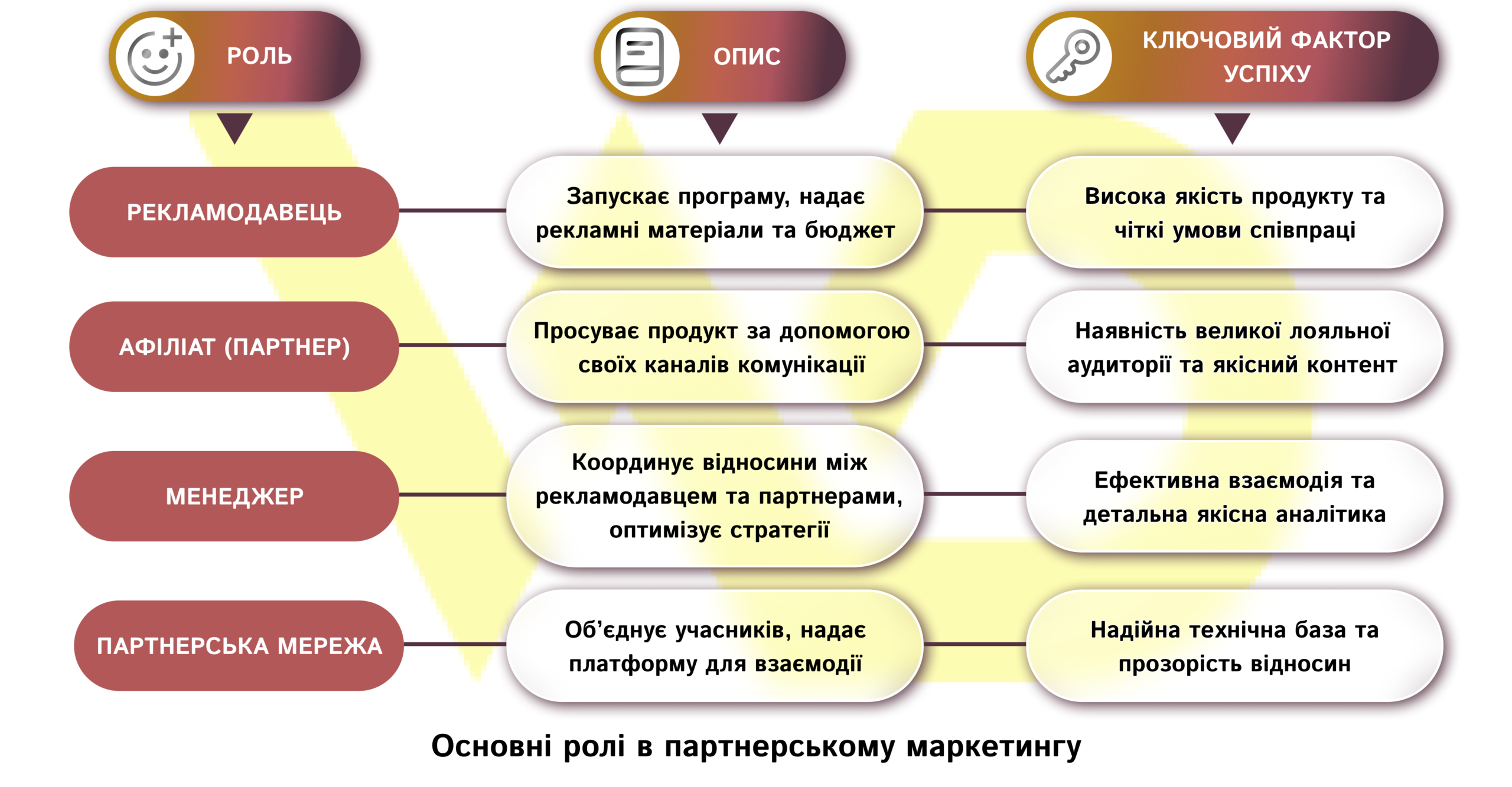Content of the article
- /01 Where is affiliate marketing used?
- /02 Basics and principles of affiliate marketing
- /03 The main types of affiliate marketing
- /04 Advantages and opportunities of affiliate marketing
- /05 Strategies for successful cooperation in affiliate marketing
- /06 How to increase earnings from an affiliate program
- /07 Affiliate marketing model in business: is it worth it or not?


Affiliate marketing is one of the most popular methods of promoting goods and services on the Internet in recent years. The affiliate marketing model, based on partnerships, allows advertisers to cooperate with independent partners – affiliates – to achieve specific results. The key participants in affiliate marketing are advertisers, affiliate program managers, and specialized networks that bring together affiliates.
In practice, affiliate marketing looks like this: a program manager connects an advertiser with a network of experienced partners who promote a product or service, and the advertiser pays for the result achieved: registration, a completed transaction (sale), or another targeted user action. This format of cooperation allows for transparent relations and guaranteed earnings for all participants.
For example, let’s imagine a blogger named Alexander. He decides to monetize his technology website by signing up for an affiliate network, choosing the right program (affiliate marketing), and starts publishing gadget reviews on his website’s blog. The manager of the chosen affiliate marketing program helps to optimize link placement and analyze statistics, which leads to a steady increase in Alexander’s earnings and the expansion of relationships with advertisers.
Later in the article, we will analyze in more detail why affiliate marketing is needed, all its features and types. We will also look at many examples of affiliate marketing to fully understand the topic.
Where is affiliate marketing used?
Affiliate marketing is used in many digital business sectors, where joint efforts help to attract targeted traffic and increase earnings for all program participants.
The main industries for using affiliate marketing are:
- online stores, where affiliate programs are needed to attract traffic through blogs, thematic sites, and social networks, which helps to increase sales;
- Banks and insurance companies that use affiliate marketing to generate leads and process applications;
- online education, where educational platforms cooperate with bloggers and educational portals to attract students to courses and consultations;
- SaaS and other digital product companies are launching affiliate marketing, where partners receive a percentage of subscriptions or sales;
- the travel industry, entertainment, and mobile applications, where recommendations and reviews influence consumer choice.
In addition, affiliate marketing is actively used in such areas as real estate, dating, gaming, cryptocurrency projects, health and fitness. Due to its flexibility, affiliate marketing adapts to the specific needs of different businesses and contributes to their development.
Basics and principles of affiliate marketing
Affiliate marketing is based on mutually beneficial relationships between participants: advertisers, affiliates, and managers. These relationships are based on clearly defined terms and conditions in affiliate programs, which guarantees transparency and stability of earnings. In this model, affiliate marketing provides advertisers with an influx of targeted traffic, while affiliates get an opportunity to earn additional income.
Roles of participants in the affiliate marketing system
To understand the essence of relationships in affiliate marketing, let’s look at the main roles:
- the advertiser initiates the program and provides content for advertising, interested in increasing sales and brand awareness;
- Affiliates (partners) – independent professionals or companies that promote the advertiser’s products through their own channels;
- the affiliate program manager coordinates relationships and monitors compliance with program terms, helps optimize the strategy to maximize earnings for all parties to affiliate marketing;
- The affiliate network unites affiliates and advertisers, providing them with a platform for secure interaction and experience exchange.
For a clearer understanding, let’s look at a table illustrating the distribution of roles in affiliate marketing:

The main types of affiliate marketing
There are several types of cooperation in the affiliate marketing model. Each of them has its own peculiarities and is used in different niches. Below, we will consider the main types of affiliate marketing and their features. For a more detailed understanding of the types of affiliate marketing, we have provided many practical examples.
CPA (Cost Per Action) in affiliate marketing
The CPA (Cost Per Action) system in affiliate marketing is based on the concept of paying for a specific user action. It can be registration, filling out a feedback form, downloading an app, etc. From a theoretical point of view, it embodies the principle of “pay for results” when an advertiser invests only in those activities that bring specific, measurable results.
Thanks to this approach, financial risks for all affiliate marketing participants are significantly reduced, as costs depend on real conversions, not just on the total reach of the target audience. Moreover, this model encourages affiliates to focus more on the quality of the traffic they attract, as it is an important factor in improving marketing campaigns. Affiliate program managers can adjust their strategies based on reliable analytical data. In this way, resources are used as efficiently as possible and conversion rates increase.

Let’s look at the Cost Per Action model in affiliate marketing on the example of Kateryna, the owner of a health website.
Kateryna actively uses affiliate marketing with a focus on attracting an audience interested in free consultations with health experts. She has integrated specially designed registration forms into her website, which she places in strategically important places: on the homepage, in articles about disease prevention, and in sections with reviews and recommendations. For each registration made through her website, the advertiser pays a certain amount of money, which allows Kateryna to receive a steady income from her website.
The affiliate program manager who works with Kateryna helps optimize pages to increase conversion, which affects the site owner’s earnings. What he does:
- uses analytics tools such as Google Analytics and heatmaps to analyze user behavior on the site, determining which elements attract more attention and stimulate action;
- conducts A/B testing of various form design options, changing the colors of buttons, headings, and the location of elements, which allows you to find the optimal solution that maximizes the number of registrations.
In addition, the affiliate marketing manager regularly consults and provides recommendations on how to improve the content: from adding testimonials from satisfied customers to placing informative blocks about the benefits of free consultations. This helps to increase the trust of visitors and encourages them to interact with the resource.
Thanks to this integrated approach, the number of registrations is regularly growing, and Kateryna’s earnings are steadily increasing. This case is a very vivid example of the effective use of affiliate marketing principles in real business.
CPS (Cost Per Sale) in affiliate marketing
In the CPS (Cost Per Sale) model of affiliate marketing, affiliates are rewarded only for actual sales, i.e. after a successful transaction is completed. This means that the advertiser pays a commission only for profitable transactions, which avoids the cost of unprofitable actions. Unlike the CPA model, where payment is made for individual actions, in CPS, an affiliate’s earnings directly depend on the number of sales made.
This approach encourages partners to implement the most effective methods of attracting customers within the chosen affiliate marketing model, as their earnings are directly proportional to the success of sales. The advertiser, in turn, receives high-quality traffic and guarantees that the money spent leads to real profits. Cooperation is based on clearly defined conditions: both parties use modern analytics tools to track results and optimize marketing strategies.
Thus, we can see that the CPS model in affiliate marketing helps to establish long-term mutually beneficial partnerships, ensuring stable revenue growth for both affiliates and advertisers.

Let’s look at the principle of CPS (Cost Per Sale) in affiliate marketing on the example of an online clothing store.
The store enters into a partnership agreement with a popular blogger who has a wide audience interested in fashion trends. The blogger publishes detailed reviews of new collections, creates stylish images, and adds a special affiliate link to his posts. When his subscribers, interested in his recommendations, click on the link and make a purchase, the blogger receives a certain percentage of the sale amount.
In this affiliate marketing model, the affiliate program manager uses modern analytical tools to accurately track each transaction, which guarantees the correct calculation of commission payments. Thanks to this system, the store gets additional sales because it receives additional high-quality traffic to its website, and the blogger gets a stable income that directly depends on the success of his recommendations. This creates a profitable partnership in which both parties benefit and earn money.
CPL (Cost Per Lead) in affiliate marketing
The CPL (Cost Per Lead) model in affiliate marketing is focused on generating leads, i.e. potential customers interested in a product or service. The basis of this model, , is based on the concept of creating and developing a database of contacts that can be used for targeted marketing campaigns in the future. The advertiser pays a commission to the partner for each contact received, which makes the model particularly attractive for companies seeking to build a long-term relationship with the audience. In Cost Per Lead, the key point is not so much an instant conversion as the creation of a high-quality data stream on the basis of which further communications with potential customers can be conducted. This approach requires careful analytics and constant monitoring of lead quality to ensure a high probability of further sales.

To understand the principle of using the CPL model in affiliate marketing, let’s take a company that offers foreign language learning as an example.
The company launches affiliate marketing and cooperates with popular educational portals and blogs. By agreement, these resources place special forms for visitors to fill out, which allow them to request a free consultation or trial lesson. Partners receive a fixed fee for each potential client who successfully fills out the form and receives a consultation. Program managers closely monitor the quality of applications, analyze feedback, and optimize the placement of forms, which stimulates the effective work of affiliates and promotes the continuous development of relationships.
This example shows that the CPL model in affiliate marketing provides a steady stream of interested customers for the company and maintains a high level of partner motivation.
CPM (Cost Per Mille) in affiliate marketing
The CPM (Cost Per Mille) model in affiliate marketing is based on payment per thousand ad impressions and is associated with the concept of mass influence and branding. In the Cost Per Mille model, the main goal is to reach the widest possible audience, increase brand awareness, and generate initial interest in the product.
CPM allows advertisers to invest in visibility and market presence, even if no direct conversion is recorded at the time of ad display. This approach is justified for companies that care about their image and active dissemination of brand information. Although this model of affiliate marketing does not guarantee direct sales, its use can significantly increase the overall level of trust and interest in the product and company, which further facilitates the transition of the audience to deeper levels of interaction.

Let’s look at the principle of Cost Per Mille in affiliate marketing on the example of a news site.
The website enters into an agreement with an advertising network under which it receives payment for each thousand impressions of ad units. Advertisements are placed on visible places on the website – on the main page, in the sections with current news, and in individual articles. The program manager regularly analyzes the statistics of impressions, taking into account such indicators as click-through rate and time spent by users on the site. Based on the data, he adjusts the location and design of ad units to increase visitor engagement. Thanks to these measures, the effectiveness of the advertising campaign increases, which contributes to a steady increase in website earnings.
Revenue Share in affiliate marketing
The Revenue Share model in affiliate marketing implies that all advertiser’s profit generated from sales or other commercial activities is divided among all participants of the affiliate program. This can be realized only in case of long-term cooperation, because the success of an affiliate is closely related to the overall financial situation of the company. The affiliate receives a constant income in the form of a percentage of the profit, which is an incentive for him to invest in product promotion.
The Revenue Share model can only be used if there is mutual trust, as both advertisers and affiliates are interested in stable earnings growth. For the model to be effective, full transparency of reporting must be ensured. This is quite easy to do – all that is needed is regular audit of financial indicators and close communication between managers and partners. Such steps allow timely adjustments to the marketing strategy and optimization of joint efforts, which contributes to the overall success of the affiliate program.
Let’s consider Revenue Share in affiliate marketing on the example of launching affiliate marketing by a software company.
The company provides affiliates with the opportunity to receive a percentage of monthly subscriptions from customers who sign up through their special links. This approach allows affiliates to earn a steady income that increases with the number of attracted users.
How the program manager helps:
- organizes regular training sessions and webinars to keep partners up to date with product innovations and to help them effectively adapt their marketing strategies;
- provides operational support and advice, helping to optimize campaigns and find new ways to attract customers.
The Revenue Share model in affiliate marketing can be successful if there is such a constant connection. It helps not only to increase turnover, but also to strengthen trust with the brand.
All affiliate marketing models are based on cost optimization, risk mitigation, and motivation of participants. Understanding their theoretical foundations allows you to efficiently allocate budgets, adapt promotion strategies, and increase earnings, which helps build transparent and stable relationships between advertisers, affiliates, and managers in a dynamic market. This, in turn, is the key to success in the world of affiliate marketing.
Advantages and opportunities of affiliate marketing
Affiliate marketing is a powerful business tool that allows you to achieve significant success if you build relationships properly. The main advantages of affiliate marketing are:
- Guaranteed earnings and transparency of cooperation.
Cooperation on CPA, CPS or Revenue Share models allows advertisers to pay only for the results they get. This creates a transparent relationship between participants, where each manager and partner feels responsible for the success of the program.
- Flexibility and adaptability of programs.
The variety of cooperation models that we have discussed above (CPA, CPS, CPL, CPM, Revenue Share) allows you to choose the best solution for each niche. Advertisers can test different approaches one by one or choose a hybrid approach, using several models for their business. Managers also have many modern analytics tools to adjust strategies to maximize earnings.
- Expansion of the partner network and new opportunities for growth.
Active participation in affiliate networks opens up additional channels for product promotion. Examples of successful cases show how established relationships between affiliates, managers, and advertisers lead to mutually beneficial business development.
- Innovative technologies and analytics.
Modern platforms allow you to track the effectiveness of each advertising channel in real time. This helps to quickly respond to changes and adjust strategies, as well as build trust within the affiliate network.
Strategies for successful cooperation in affiliate marketing
Successful affiliate marketing is based on a comprehensive approach to partner selection, effective campaign management, and the use of modern analytics tools. According to Statista, the global affiliate marketing market is growing by an average of 10% annually and has already exceeded $17 billion. This confirms the need for a strategic approach to cooperation between advertisers and affiliates. Let’s consider the key factors that should form the basis for building a cooperation strategy.
Choosing the best affiliate programs
The strategy of choosing an affiliate program determines the level of income and the effectiveness of the marketing campaign. It is important to consider:
- cooperation model: CPA (cost per action), CPS (percentage of sales), CPL (cost per lead), CPM (cost per impression), and Revenue Share (revenue share). For example, 60% of e-commerce companies use CPA and CPS because these models provide predictable profitability.
- Traffic quality: choosing the right traffic source is one of the most important factors in affiliate marketing;
- commission level and payment terms: some programs offer a fixed fee, while others provide progressive commissions based on sales volume or users attracted.
Building transparent and long-term relationships
Affiliate marketing works effectively only if there is complete trust between the advertiser and the affiliate. How to achieve this?
- Use transparent analytics systems (Google Analytics, Voluum, Post Affiliate Pro).
- Create transparent reports on a regular basis: market research shows that 79% of partners prefer brands that regularly provide detailed reports on campaign performance.
- Organize training sessions, implement webinars, provide additional information materials, and support affiliates, which increases the engagement and motivation of all participants and improves the overall results of the program.
Use of analytics and automation
Modern technologies allow it:
- automate processes: tracking systems and AI analytics help to quickly analyze traffic efficiency and improve conversions, reducing the time for manual data processing;
- optimize advertising campaigns: platforms such as Affise or Impact Radius can increase advertising efficiency by up to 30% by adjusting bids, segmenting the audience, and personalizing content;
- implement A/B testing: testing different variants of advertising materials allows you to increase the CTR (Click-Through Rate) and conversion rate.
Diversification of engagement channels
Affiliates engage their audience through SEO, content marketing, social media, email campaigns, and advertising. According to HubSpot, 58% of traffic is generated through blog articles and reviews, and 32% of buyers make decisions based on blogger recommendations. Email marketing provides 4.29% conversion rate, and advertising networks, such as Google Ads, allow for effective audience targeting. The combination of these channels increases the reach and stability of earnings.
Want to increase traffic and conversions with SEO and advertising?
WEDEX specialists will help you attract your target audience and increase your revenue! Leave a request and we will select the best SEO strategy and set up an effective advertising campaign for your business.
How to increase earnings from an affiliate program
In order to increase earnings in the affiliate marketing system, it is necessary to develop all parts of the affiliate program in a comprehensive manner. Success here depends on constant optimization of strategies, improvement of traffic quality, and close interaction between advertisers, managers, and affiliates. The following recommendations will help you build an effective system that can ensure a steady increase in earnings.

- The importance of analytics and regular monitoring.
If managers and affiliates do not pay due attention to collecting and analyzing statistical data, the budget is spent inefficiently. For example, the use of inappropriate advertising creatives or the wrong target audience can lead to low conversion rates, which will reduce earnings. Regular tracking of indicators and prompt strategy adjustments help to avoid these mistakes.
- A meticulous approach to choosing partners.
Advertisers that do not conduct a thorough analysis of potential affiliates often enter into cooperation with those whose audience does not match the product’s theme. This leads to a decrease in traffic quality and minimal conversion. The best solution is to choose partners that have already established themselves in their niche and have an active target audience and can prove it with successful cases.
- Close communication between affiliate marketing participants.
Regular meetings, webinars, and exchange of experience between managers and affiliates lead to a more specific and better understanding of the overall strategy. Without constant feedback, participants do not know what changes need to be made to improve results, which negatively affects motivation and quality of work.
- Being ready for testing is the #1 necessity.
Focusing exclusively on the CPA model or on one traffic source limits the possibilities for revenue growth and diversification. It is important to test different models and channels to adapt to market changes and respond quickly to new trends. Managers should encourage innovation and the introduction of new tools that can improve campaign performance.
Affiliate marketing model in business: is it worth it or not?
Affiliate marketing is a dynamically developing affiliate marketing model in 2025. Here, each participant – from advertiser to affiliate to manager – plays a unique role. Due to the variety of cooperation models, such as CPA, CPS, CPL, CPM, and Revenue Share, business owners have the opportunity to choose the best conditions for attracting quality traffic and increasing earnings.
Well-built relationships, active participation of the manager in program optimization, and the use of modern analytics tools are the key to stability and success. Real-life examples show that even a small online store can achieve significant results in affiliate marketing by taking advantage of an affiliate network.
Thus, affiliate marketing opens up wide opportunities for business development and allows each participant of the system to receive a decent reward for their efforts and build long-term, mutually beneficial relationships.







 11/03/2025
11/03/2025  2540
2540


